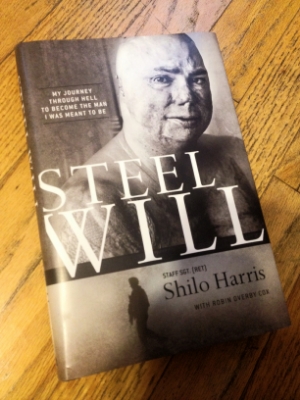Although I’ve taken pretty much a hiatus from reviews this month, when I was asked to review Steel Will, I quickly said “yes” once I realized what the book is about. The men and women of our armed forces are near and dear to my heart. I’m an Afghanistan veteran and former Army-reservist. (My contract just ended last December.) My husband is active-duty Navy, and I’m currently working for the Navy as a civilian.
When I deployed to Kandahar, my job as a photojournalist often took me “outside the wire,” meaning outside the relatively-safe base and into the Afghan communities. Through all the convoys, helo flights, and foot patrols, God kept me safe. There were a couple of times I remember being truly terrified, but for the most part I always had a peace that I wasn’t going to die or be badly hurt. Not everyone is so fortunate. And not all wounds are visible.

Steel Will is the story of Staff Sgt. (Ret.) Shilo Harris. The tagline is “My journey through hell to become the man I was meant to be.”
Harris begins his book by telling about the fateful day in Iraq when his vehicle ran over an improvised explosive device (IED). I didn’t think Harris by any means glorified the gore, but he was descriptive enough that I realized just how horrific his wounds were. I even thought, he shouldn’t be alive.
Chapter two goes back to Harris’ childhood. He describes the events that led up to his enlistment into the Army after 9/11. His father had fought in Vietnam and came back a changed man, for the worse. And back then people didn’t really understand post-traumatic stress disorder (PTSD) yet. Although Harris grew up surrounded by family strife, drugs, and alcoholism, Harris was blessed to straighten out his life and meet Kathreyn, the woman who became his wife and was responsible for introducing him to the saving grace of Jesus. It’s obvious very quickly that Harris and Katheryn have a loving relationship, and that she’s a strong woman.
Harris’ book tells about many of the men he served with. The stories are both humorous and sad. He also brings to light some of the horrors of war as well as tragic circumstances many Iraqis faced daily.
About halfway through the book, Harris describes in greater detail the day of the ambush, as well as the IED blast itself. More than a third of his body was burned. He lost his ears and several fingers. Harris had a broken back and a fractured collarbone. When his wife Kathreyn arrived at the hospital in Germany, every part of his body except for his toes was bandaged. Kathreyn was told Harris’ chances of survival were 2 percent. Harris and one other Soldier survived the explosion, but three men didn’t make it.
As Harris’ body healed, he struggled with understanding why God had spared him, and not his men. And then he was angry, angry that God had allowed this to happen to him and to his family.
Besides the men Harris served with, he describes the various wounded warriors he met while recovering. It’s incredible what these troops and their families have survived. One phrase stood out to me. Harris writes, “If you ever want to meet a hero, you need to meet my wife.” Their relationship is inspiring. In a day and age where many people focus on what makes themselves happy, Kathreyn exhibited an unusual sacrificial love for her husband.
They did have obstacles to overcome, obviously. And it wasn’t just Shilo’s healing. Kathreyn had to protect and mother Shilo for months on end; she was his nurse for much of the time. So it was difficult for them to adjust their roles back to husband and wife, and lovers.
Over time, Harris became involved in different wounded warrior organizations and programs. He was able to travel around and serve as an encouragement to other warriors, newly wounded. He’s met presidents George W. Bush and Barack Obama. He and his family even participated in ABC’s Extreme Makeover: Home Edition.
I could not put this book down. There were multiple places in the book that had me choked up: the stories of those that didn’t make it, the wounded warriors, the black outs and rages, traumatic brain injuries, the PTSD… These are things that many military families face on a daily basis. I’ve witnessed fellow Soldiers, who I believe suffer from PTSD, self-medicate with alcohol rather than talk about their experiences and feelings to a friend or professional. Harris openly discusses his experiences and journey of healing during a time when many still don’t speak about theirs and don’t ask for help. But they do need help.
The book ends with several pages devoted to the Soldiers who served with Staff Sgt. Shilo Harris and died that day, Feb. 19, 2007, in Iraq. And finally, Harris and his wife have included a comprehensive list of resources to help wounded warriors.
You can find out more info about Shilo Harris at his website www.shiloharris.com, as well as photos, videos, and more resources.
Note: I received a free copy of Steel Will to read and review. The opinions expressed are my own.














